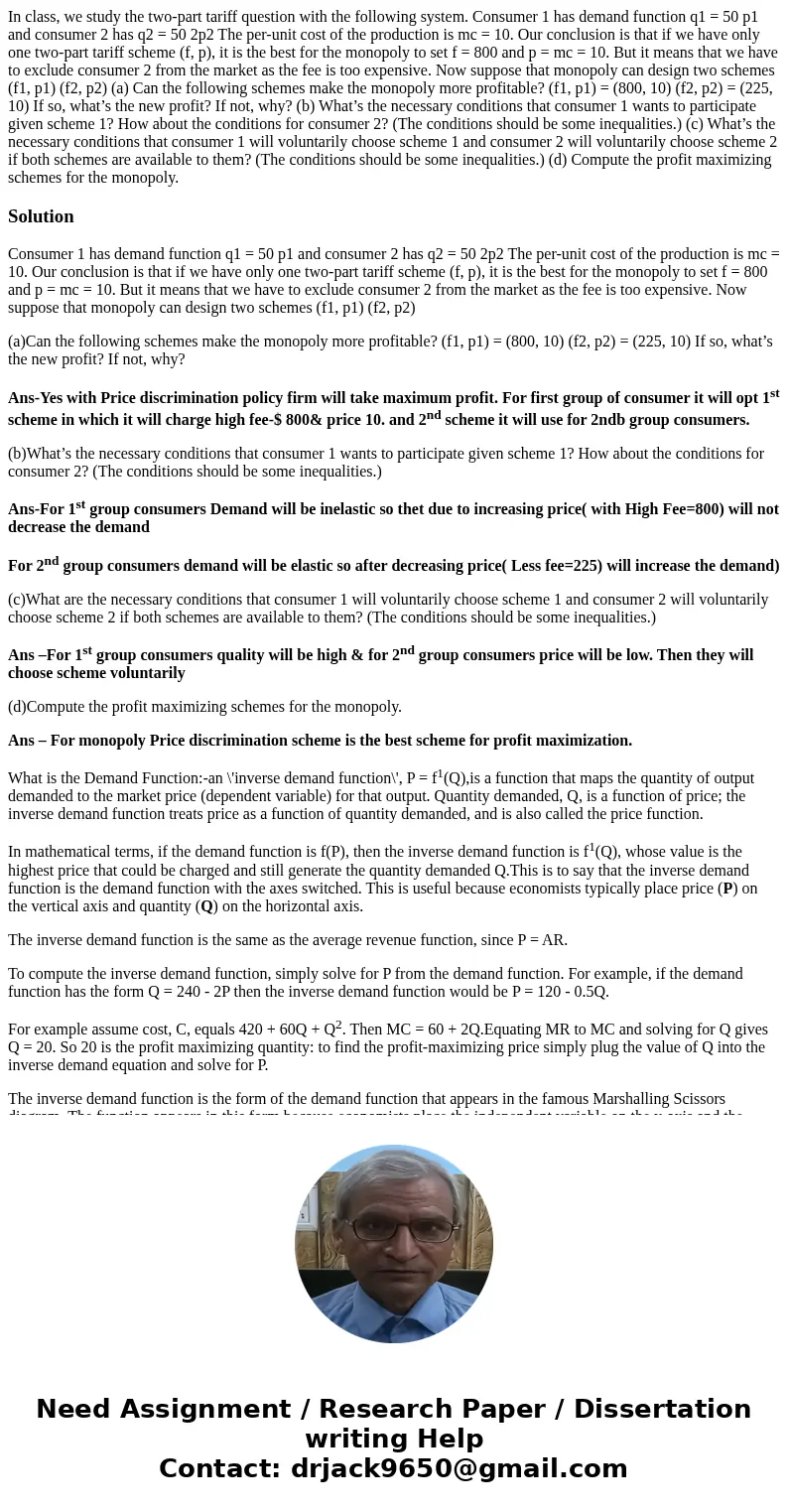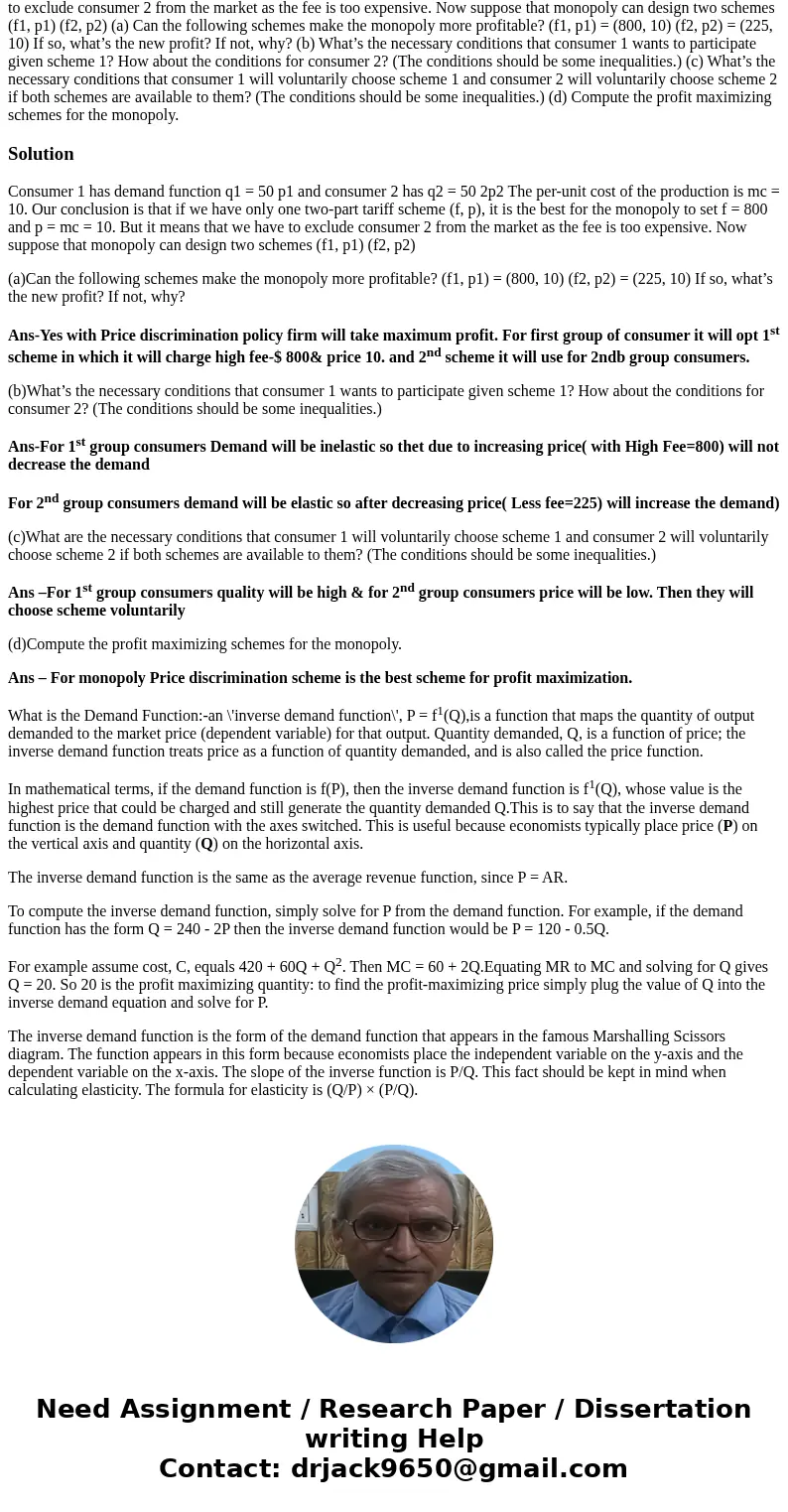In class we study the twopart tariff question with the follo
In class, we study the two-part tariff question with the following system. Consumer 1 has demand function q1 = 50 p1 and consumer 2 has q2 = 50 2p2 The per-unit cost of the production is mc = 10. Our conclusion is that if we have only one two-part tariff scheme (f, p), it is the best for the monopoly to set f = 800 and p = mc = 10. But it means that we have to exclude consumer 2 from the market as the fee is too expensive. Now suppose that monopoly can design two schemes (f1, p1) (f2, p2) (a) Can the following schemes make the monopoly more profitable? (f1, p1) = (800, 10) (f2, p2) = (225, 10) If so, what’s the new profit? If not, why? (b) What’s the necessary conditions that consumer 1 wants to participate given scheme 1? How about the conditions for consumer 2? (The conditions should be some inequalities.) (c) What’s the necessary conditions that consumer 1 will voluntarily choose scheme 1 and consumer 2 will voluntarily choose scheme 2 if both schemes are available to them? (The conditions should be some inequalities.) (d) Compute the profit maximizing schemes for the monopoly.
Solution
Consumer 1 has demand function q1 = 50 p1 and consumer 2 has q2 = 50 2p2 The per-unit cost of the production is mc = 10. Our conclusion is that if we have only one two-part tariff scheme (f, p), it is the best for the monopoly to set f = 800 and p = mc = 10. But it means that we have to exclude consumer 2 from the market as the fee is too expensive. Now suppose that monopoly can design two schemes (f1, p1) (f2, p2)
(a)Can the following schemes make the monopoly more profitable? (f1, p1) = (800, 10) (f2, p2) = (225, 10) If so, what’s the new profit? If not, why?
Ans-Yes with Price discrimination policy firm will take maximum profit. For first group of consumer it will opt 1st scheme in which it will charge high fee-$ 800& price 10. and 2nd scheme it will use for 2ndb group consumers.
(b)What’s the necessary conditions that consumer 1 wants to participate given scheme 1? How about the conditions for consumer 2? (The conditions should be some inequalities.)
Ans-For 1st group consumers Demand will be inelastic so thet due to increasing price( with High Fee=800) will not decrease the demand
For 2nd group consumers demand will be elastic so after decreasing price( Less fee=225) will increase the demand)
(c)What are the necessary conditions that consumer 1 will voluntarily choose scheme 1 and consumer 2 will voluntarily choose scheme 2 if both schemes are available to them? (The conditions should be some inequalities.)
Ans –For 1st group consumers quality will be high & for 2nd group consumers price will be low. Then they will choose scheme voluntarily
(d)Compute the profit maximizing schemes for the monopoly.
Ans – For monopoly Price discrimination scheme is the best scheme for profit maximization.
What is the Demand Function:-an \'inverse demand function\', P = f1(Q),is a function that maps the quantity of output demanded to the market price (dependent variable) for that output. Quantity demanded, Q, is a function of price; the inverse demand function treats price as a function of quantity demanded, and is also called the price function.
In mathematical terms, if the demand function is f(P), then the inverse demand function is f1(Q), whose value is the highest price that could be charged and still generate the quantity demanded Q.This is to say that the inverse demand function is the demand function with the axes switched. This is useful because economists typically place price (P) on the vertical axis and quantity (Q) on the horizontal axis.
The inverse demand function is the same as the average revenue function, since P = AR.
To compute the inverse demand function, simply solve for P from the demand function. For example, if the demand function has the form Q = 240 - 2P then the inverse demand function would be P = 120 - 0.5Q.
For example assume cost, C, equals 420 + 60Q + Q2. Then MC = 60 + 2Q.Equating MR to MC and solving for Q gives Q = 20. So 20 is the profit maximizing quantity: to find the profit-maximizing price simply plug the value of Q into the inverse demand equation and solve for P.
The inverse demand function is the form of the demand function that appears in the famous Marshalling Scissors diagram. The function appears in this form because economists place the independent variable on the y-axis and the dependent variable on the x-axis. The slope of the inverse function is P/Q. This fact should be kept in mind when calculating elasticity. The formula for elasticity is (Q/P) × (P/Q).


 Homework Sourse
Homework Sourse